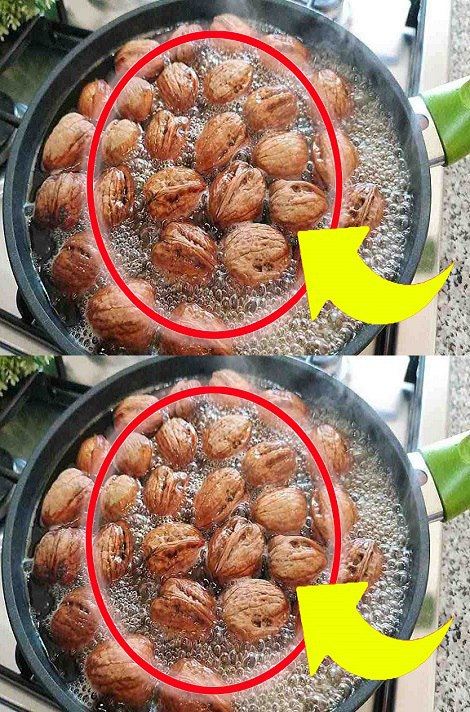ADVERTISEMENT
Why Boil Walnuts?
Boiling walnuts may sound like a strange idea at first, but it’s actually a technique used to bring out the best qualities of the nuts, making them even more delicious and versatile. Here’s why you’ll want to give it a try:
- Remove Bitter Skin: Walnuts have a thin, bitter skin that can sometimes overpower their natural flavor. By boiling them, you can easily remove this skin, revealing the mild, nutty center that you’ll love even more.
- Enhance Flavor: Boiling walnuts in water helps to bring out their natural oils, making them richer in flavor. The process can intensify the nuttiness, making them a more delicious addition to your dishes.
- Make Them Easier to Peel: If you’ve ever tried to peel walnuts, you know it can be a time-consuming and messy process. Boiling them softens the skin, making it much easier to peel off—saving you time and frustration.
- Improve Texture: Boiling walnuts makes them softer and gives them a smoother texture. This is especially useful if you’re planning to use them in recipes like smoothies, nut butter, or sauces, where a smoother consistency is desired.
- Increase Digestibility: Walnuts are packed with nutrients and healthy fats, but they can sometimes be hard to digest in their raw form. By boiling them, you may make the nuts easier to digest, improving the overall benefits.
The Boiling Process: Step-by-Step
Now that you know why you should try boiling your walnuts, let’s dive into how to do it. The process is incredibly simple and quick, so don’t worry about spending too much time in the kitchen.
What You’ll Need:
- 1 cup of walnuts (in-shell or shelled)
- A large pot of water
- A strainer or slotted spoon
- Optional: Salt, spices, or sweeteners for flavor (if you want to get creative)
Step 1: Boil the Water
Start by bringing a large pot of water to a boil. You’ll want enough water to completely submerge the walnuts. If you’re boiling a small amount of walnuts, about 2–3 cups of water should suffice.
Step 2: Add the Walnuts
Once the water is boiling, carefully add your walnuts to the pot. If they are still in the shell, you’ll want to be extra careful when placing them in the water. Boiling shelled walnuts works best, but if you do have in-shell walnuts, the outer shell will soften and crack during the boiling process, making it easier to remove.
Step 3: Boil for 5-10 Minutes
Let the walnuts boil for about 5 to 10 minutes. This is the key part of the process, as the water softens the walnut skins, allowing them to be peeled away with minimal effort.
Step 4: Drain and Cool
After boiling, drain the walnuts using a strainer or slotted spoon. Let them cool for a few minutes, as they will be hot right out of the water.
Step 5: Peel and Enjoy!
Once the walnuts have cooled enough to handle, you can easily peel away the thin, bitter skin using your fingers or a cloth. For shelled walnuts, this step will be even simpler, as the skins will likely come off with just a light squeeze. You can now enjoy your beautifully peeled walnuts or use them in your favorite recipes!
Creative Ways to Use Your Boiled Walnuts
Boiled walnuts are a great addition to a variety of dishes. Here are just a few ways to incorporate them into your meals:
- Baked Goods: Chopped boiled walnuts are perfect for adding a nutty crunch to muffins, cakes, or cookies. Their enhanced flavor and smooth texture make them the ideal addition to baked treats.
- Smoothies and Shakes: Add boiled walnuts to your smoothies for a creamy, nutty base. The softer texture makes them blend seamlessly with fruits, greens, and other ingredients.
- Nut Butter: Use boiled walnuts to make your own homemade nut butter. The smooth, creamy texture after boiling makes it easier to process in a food processor or blender.
- Salads: Toss boiled walnuts into your salads for a satisfying crunch. The mellow flavor of the boiled nuts complements fresh greens, fruits, and vinaigrette dressings.
- Savory Dishes: Walnuts add great flavor and texture to savory dishes, too. Sprinkle them over roasted vegetables, grain bowls, or stir them into pasta sauces for an unexpected twist.
- Snacks: Boiled walnuts can be a delicious, healthy snack on their own. You can lightly salt them or season them with herbs and spices for extra flavor.
Tips for the Best Walnuts
- Use Fresh Walnuts: For the best flavor and texture, make sure you’re using fresh walnuts. Old, stale walnuts can have a bitter taste that may not improve after boiling.
- Don’t Overcook: Be careful not to boil the walnuts for too long. Overcooking can make them mushy and lose their texture. Keep the boil time to around 5–10 minutes for optimal results.
- Experiment with Flavors: Feel free to experiment by adding seasonings to the water when boiling. A little salt, cinnamon, or even a touch of honey can infuse the walnuts with unique flavors.
- Storage: If you have extra boiled walnuts, store them in an airtight container in the refrigerator for up to a week. You can also freeze them for longer storage, though the texture may change slightly upon thawing.
The Takeaway
Boiling walnuts is a simple yet ingenious trick that will elevate your cooking game. Whether you want to enhance their flavor, make them easier to peel, or improve their digestibility, this method will revolutionize how you enjoy walnuts. It’s a great way to add a special touch to both sweet and savory dishes and will quickly become a technique you can’t live without.
Next time you’re working with walnuts, try boiling them first—it’s a small change that makes a big difference!
